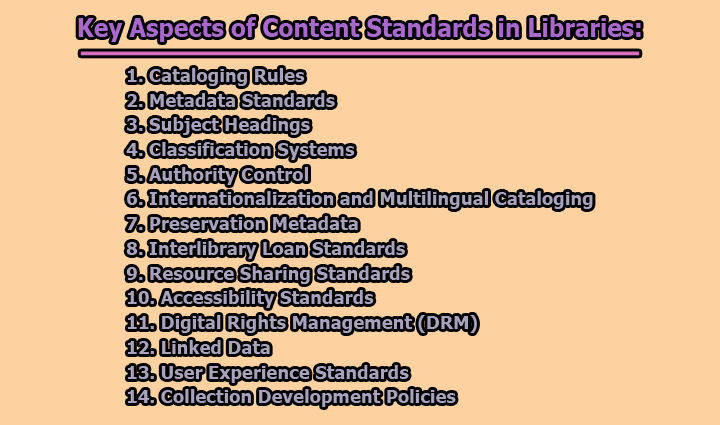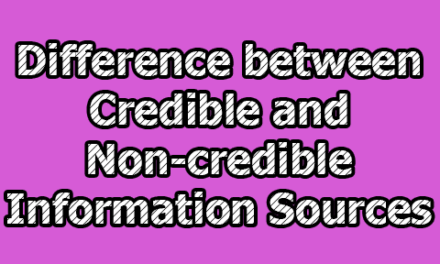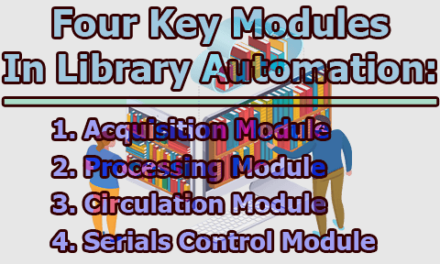Key Aspects of Content Standards in Libraries:
Libraries play a pivotal role in the dissemination of knowledge and information, serving as crucial hubs for education, research, and community engagement. In order to efficiently organize, access, and share resources, libraries adhere to a set of content standards. In the rest of this article, we will explore the key aspects of content standards in libraries.
1. Cataloging Rules: Cataloging rules serve as the foundation for the systematic organization of information about library resources. These rules provide guidelines on how to create consistent and accurate bibliographic records, ensuring that users can easily find and access the materials they need. One of the most significant developments in cataloging rules is the transition from the Anglo-American Cataloging Rules, 2nd edition (AACR2) to the Resource Description and Access (RDA). RDA represents a shift towards a more flexible, user-oriented approach to cataloging, emphasizing the importance of describing resources in ways that resonate with the needs and expectations of library users.
Under AACR2, cataloging focused on a set of rigid rules, with a primary emphasis on the physical attributes of a resource. In contrast, RDA encourages catalogers to consider the functional and intellectual characteristics of resources, fostering a more holistic representation. This shift reflects the evolving nature of libraries, where digital resources and diverse formats are increasingly prevalent. The move to RDA aligns cataloging practices with the changing landscape of information resources and promotes greater inclusivity and relevance in catalog records.
2. Metadata Standards: Metadata standards play a crucial role in the digital environment, defining how information is described, structured, and represented. These standards are essential for enhancing the discoverability and interoperability of digital resources. Among the notable metadata standards, Dublin Core provides a simple and widely applicable set of elements for describing resources, making it suitable for various contexts. Meanwhile, the Metadata Object Description Schema (MODS) offers a more robust and structured approach, particularly suitable for libraries and cultural institutions.
Another significant metadata standard is the Metadata Encoding and Transmission Standard (METS), which provides a framework for structuring complex digital objects. METS allows libraries to represent relationships between different components of a resource, supporting the preservation and presentation of digital materials. By adhering to metadata standards, libraries ensure that digital resources are not only easily searchable but also capable of seamless integration with other systems and platforms.
3. Subject Headings: Subject headings are standardized terms or phrases used to describe the content of library resources, enabling users to efficiently locate materials on specific topics. The Library of Congress Subject Headings (LCSH) is a widely used controlled vocabulary in this regard. LCSH encompasses a vast array of subjects, providing a standardized and consistent way to index and retrieve resources across different libraries.
The evolution of subject headings reflects the dynamic nature of knowledge and societal changes. As new fields of study emerge and interdisciplinary connections grow, subject headings must adapt to encompass these developments. The inclusion of diverse perspectives and the recognition of evolving terminology are crucial aspects of subject heading standards. Through adherence to such standards, libraries ensure that their catalogs remain responsive to changing user needs and the expanding landscape of knowledge.
4. Classification Systems: Classification systems provide organizational frameworks for assigning unique codes to library materials based on their subject content. The Dewey Decimal Classification (DDC) and the Library of Congress Classification (LCC) are two widely adopted systems, each with its own strengths and applications.
The Dewey Decimal Classification is a hierarchical system that categorizes knowledge into ten main classes, each further divided into subclasses. This system simplifies the arrangement of materials on library shelves, making it easy for users to browse and locate resources within specific subject areas. It is particularly well-suited for public libraries and smaller collections.
On the other hand, the Library of Congress Classification is more complex and designed for larger academic and research libraries. It organizes materials based on specific subject areas and disciplines, employing a combination of letters and numbers for precise classification. The adoption of these classification systems ensures consistency and efficiency in the arrangement and retrieval of library materials.
5. Authority Control: Authority control is a critical aspect of content standards that ensures consistency in the use of names and terms across the library catalog. Establishing authoritative forms of names and terms minimizes confusion and enhances precision in retrieval. For example, a single author’s name should have a standardized form to prevent variations or misspellings.
Authority control is particularly important in the context of author names, subject headings, and corporate names. It involves creating and maintaining authority records that serve as references for authorized forms of entities. The Library of Congress Authority File (LCAF) is a well-known example of a centralized authority control system used by libraries worldwide. Adhering to authority control standards ensures that users can reliably find and access materials related to a specific author, subject, or entity without encountering inconsistencies in cataloging.
6. Internationalization and Multilingual Cataloging: As libraries strive to serve diverse user populations, internationalization and multilingual cataloging become crucial aspects of content standards. These standards aim to adapt cataloging practices to accommodate various languages, reflecting the linguistic diversity of library users. Multilingual cataloging involves describing resources in multiple languages, ensuring that users searching in different languages can access relevant materials.
Standards such as MARC 21 and RDA incorporate provisions for representing and searching in multiple languages. MARC 21, in particular, allows for the representation of bibliographic records in different scripts and character sets, facilitating the cataloging of materials in languages with distinct writing systems. The adoption of internationalization and multilingual cataloging standards enhances inclusivity and ensures that library catalogs are accessible to users with varying language preferences.
7. Preservation Metadata: Preservation metadata standards address the long-term accessibility and authenticity of digital resources, acknowledging the challenges posed by digital deterioration and technological obsolescence. As libraries increasingly digitize their collections, preserving digital materials becomes a critical concern. Preservation metadata provides the necessary information to ensure the continued accessibility and integrity of digital resources over time.
The Preservation Metadata: Implementation Strategies (PREMIS) standard is a widely adopted framework for defining and exchanging preservation metadata. PREMIS specifies the information necessary for managing digital preservation activities, including technical details, provenance, and rights management. Adherence to preservation metadata standards is essential to safeguarding the longevity of digital collections and mitigating the risks associated with format obsolescence and technological changes.
8. Interlibrary Loan Standards: Interlibrary loan (ILL) standards facilitate resource sharing among libraries, enabling users to access materials not available in their local collections. These standards establish protocols for requesting, borrowing, and lending materials between libraries. One notable standard is the ISO 10160/10161 protocol, which provides a framework for ILL transactions and communication between different library systems.
The NISO ILL Protocol, developed by the National Information Standards Organization, is another key standard that defines the communication format and protocols for ILL requests. Adherence to interlibrary loan standards ensures a smooth and efficient exchange of materials between libraries, expanding the range of resources available to users and promoting collaborative sharing within the library community.
9. Resource Sharing Standards: Resource sharing standards go beyond interlibrary loan protocols to encompass broader initiatives for collaborative access to resources. Standards such as Z39.50 and OpenURL play crucial roles in enabling seamless access and sharing of resources across different library systems.
Z39.50 is a protocol that facilitates the searching and retrieval of information from distributed databases, allowing libraries to share resources and provide access to diverse collections. OpenURL, on the other hand, is a standard for linking between information resources, providing a standardized syntax for the exchange of metadata between different systems. These resource sharing standards contribute to a more interconnected library landscape, where users can easily access a wealth of resources from various sources.
10. Accessibility Standards: Ensuring that library resources are accessible to individuals with disabilities is a fundamental consideration in contemporary library practices. Accessibility standards, such as the Web Content Accessibility Guidelines (WCAG) and Section 508 compliance, guide libraries in creating inclusive digital environments.
WCAG provides a set of guidelines for designing web content to be more accessible, covering aspects such as text alternatives for non-text content, keyboard navigation, and compatibility with assistive technologies. Section 508 of the Rehabilitation Act outlines accessibility requirements for federal agencies in the United States, influencing the development of accessible digital content in libraries. Adhering to these standards ensures that libraries cater to the diverse needs of users, including those with visual, auditory, or motor impairments.
11. Digital Rights Management (DRM): Digital Rights Management (DRM) standards are crucial in addressing copyright issues in the digital realm. Libraries often grapple with ensuring that digital resources are used in compliance with copyright laws and licensing agreements. Standards such as Creative Commons licenses provide a framework for creators to specify the permissions and restrictions associated with their works. Libraries adhere to these standards to navigate the legal landscape of digital content, ensuring that they respect intellectual property rights while providing users with appropriate access to digital materials. DRM standards play a vital role in balancing access and usage restrictions, safeguarding both the rights of content creators and the needs of library users.
12. Linked Data: Linked data standards are transformative in enhancing the discoverability and interconnectedness of library resources. The Linked Data movement advocates for exposing and connecting datasets on the web, enabling more meaningful relationships between pieces of information. In the library context, the Bibliographic Framework Initiative (BIBFRAME) is an example of a linked data approach to bibliographic information. BIBFRAME leverages web technologies to link related resources, providing richer contextual information and improving the user’s experience in navigating interconnected knowledge. Linked data standards contribute to breaking down silos of information, fostering a more interconnected and dynamic library ecosystem.
13. User Experience Standards: User experience (UX) standards focus on creating intuitive and user-friendly interfaces for library systems. The User Experience Design for Search (UES) standard, for instance, emphasizes designing search interfaces that are efficient, effective, and satisfying for users. These standards take into account factors such as user interface design, search result relevance, and accessibility. By adhering to UX standards, libraries enhance the overall usability of their catalogs, making it easier for users to search, discover, and access the information they need. Positive user experiences contribute to increased user satisfaction and engagement with library resources.
14. Collection Development Policies: While not a technical standard in the traditional sense, collection development policies are integral guidelines for the systematic growth and management of library collections. These policies provide a framework for librarians to make informed decisions about acquiring, maintaining, and deselecting materials. Collection development policies consider factors such as user needs, budget constraints, and the library’s mission. By adhering to these policies, libraries ensure that their collections align with the educational, research, and recreational needs of their user communities. Collection development policies serve as strategic tools for shaping the identity and relevance of a library within its broader institutional context.
In conclusion, the key aspects of content standards in libraries underscores their fundamental role in shaping the modern information landscape. From the traditional cataloging rules and classification systems to the dynamic realms of digital preservation, accessibility, and user experience, these standards collectively contribute to the seamless organization and accessibility of library resources. As libraries continue to adapt to technological advancements and societal changes, the adherence to content standards remains paramount in ensuring that libraries not only meet the diverse needs of their user communities but also stay resilient and responsive in an era of rapid information expansion. The ongoing development and implementation of these standards are fundamental to the enduring mission of libraries as vibrant hubs of knowledge and community engagement.

Assistant Teacher at Zinzira Pir Mohammad Pilot School and College










